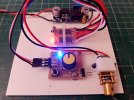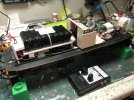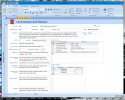Greg Elmassian
Guest
Some people have used this one, really the most smoke I have seen, and it is set to modulate the fan.




Just out of interest Jimmy does that reverse the polarity or are they bi-polarity?I use two wire bi-colour LEDs, however I use the motor outlets, and as the motor direction is reversed, then the LED changes colour.
Ah SQL hm Swahili to me, cant do databases which is why when I had my Battery records on the PC and used a spreadsheet. Ok with spreadsheet manipulation.Having just had a splendid day of instruction from dunnyrail, I felt ready to go ahead with my first RC/Battery conversion, on my old analogue LGB 2051.
I made it more complicated by re-using the bi-colour LEDs I had fitted when it was still track powered, themselves replacing the ancient LGB bulb & prism arrangement. That meant adapting the Fosworks directional lighting output to operate a relay DPDT with voltage splitter to change polarity, but it all works (on the bench at least) after many hours of muttering and experimentation and gives constant lighting which changes with the movement of the loco. As intended for each loco I am converting, a Mylocosound card has been fitted to get the neighbours more involved in my hobby.
View attachment 303744
The picture shows it all fitting in theory, I'm dreading attempting to put back the body later.
Following dunnyrail's example of meticulous record-keeping, but in my own geeky way, I also set up loco records on the railway's SQL Server database, to keep a track on what I've been up to.
View attachment 303745
That was how I had it with track power, but this time I thought it would be fun to make them constant voltage at all speeds and also stay on when static, if nothing else just to learn about the magic of electrickeryI use two wire bi-colour LEDs, however I use the motor outlets, and as the motor direction is reversed, then the LED changes colour.
They are two wire bi-polarity, the anode becomes the cathode and vis versa, so current one direction red, current the opposite direction white, or what ever colour you have chosenJust out of interest Jimmy does that reverse the polarity or are they bi-polarity?


I like them. Cheap and easy to use, with only 2 leads, so my limited brain can handle the idea. For the heck of it, I used a pair of red/greens to make some little ground signals at the exit of my 2 road loco shed, which are controlled by a supplementary switch on the point motor wired as a DPDT polarity changer , thereby automatically showing the appropriate aspect for whichever road is set.They are two wire bi-polarity, the anode becomes the cathode and vis versa, so current one direction red, current the opposite direction white, or what ever colour you have chosen

The trip to Aus in April next year is becoming more interesting, although we'll be staying mainly in Brisbane, we will need to pass through Bundaberg en route to Bargara, if you're free it would be nice to see what others are up to in their gardens ;-)Fitted my gravel train with a Viper Loco10 motor controller and test ran it.
This is a "matched train" in that the loco and gravel tubs are permanently connected as the batteries and R/C components are housed inside the tubs
Blog has description and pictures

Gravel Train
This train is a “matched” train, the motor is the only component fitted to the loco thus the tubs cannot be separated from the loco. I ma...ringbalin-light-railway.blogspot.com
This is the last one on the "to do list" (well not quite there is a garret project sulking in a box in the workshop) but now I have recovered from my surgery I have to spend time doing things like a couple painting projects and SWMBO wants the windows cleaned.
Plus there is the overgrown weed filled layout garden to tend to.
The micro-viper is an OK unit - pretty trouble freeFitted my gravel train with a Viper Loco10 motor controller and test ran it.
This is a "matched train" in that the loco and gravel tubs are permanently connected as the batteries and R/C components are housed inside the tubs
Blog has description and pictures

Gravel Train
This train is a “matched” train, the motor is the only component fitted to the loco thus the tubs cannot be separated from the loco. I ma...ringbalin-light-railway.blogspot.com
This is the last one on the "to do list" (well not quite there is a garret project sulking in a box in the workshop) but now I have recovered from my surgery I have to spend time doing things like a couple painting projects and SWMBO wants the windows cleaned.
Plus there is the overgrown weed filled layout garden to tend to.
From my position as a complete beginner who needs to work things out very slowly, and with Greg's reminder above, I have a feeling that three-legged LEDs might actually be better with the Fosworks Cobra directional lighting outputs as supplied, avoiding having to use a relay to manage the two lead ones, which is effectively duplicating functionality and taking up precious space. Next time I put in an order for LEDs, I'll get some and have an experiment. Note that I'm aiming to power lamps independent of the motor, to avoid that slow speed flickering business.Thanks Jimmy, so Bi-Polar led‘s then, heard them mentioned but never had a clue what they were. Seam like the answer to lighting up many of my batteryficated locomotives. Possible winter project.
After working out the anode and cathode polarity wiring to get your colours the right way around, which ultimately relies on trial and error as it depends on the motor wiring and gearbox arrangements, you then have two choices:From my position as a complete beginner who needs to work things out very slowly, and with Greg's reminder above, I have a feeling that three-legged LEDs might actually be better with the Fosworks Cobra directional lighting outputs as supplied, avoiding having to use a relay to manage the two lead ones, which is effectively duplicating functionality and taking up precious space. Next time I put in an order for LEDs, I'll get some and have an experiment.
